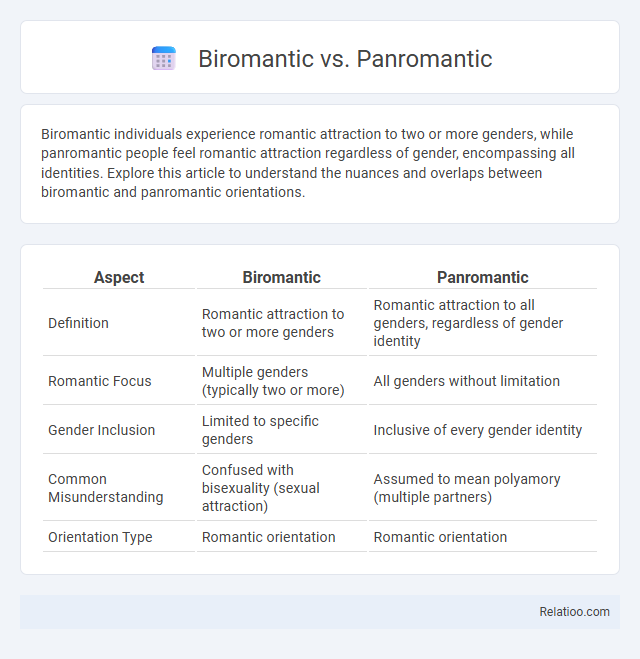Biromantic individuals experience romantic attraction to two or more genders, while panromantic people feel romantic attraction regardless of gender, encompassing all identities. Explore this article to understand the nuances and overlaps between biromantic and panromantic orientations.
Table of Comparison
| Aspect | Biromantic | Panromantic |
|---|---|---|
| Definition | Romantic attraction to two or more genders | Romantic attraction to all genders, regardless of gender identity |
| Romantic Focus | Multiple genders (typically two or more) | All genders without limitation |
| Gender Inclusion | Limited to specific genders | Inclusive of every gender identity |
| Common Misunderstanding | Confused with bisexuality (sexual attraction) | Assumed to mean polyamory (multiple partners) |
| Orientation Type | Romantic orientation | Romantic orientation |
Understanding Romantic Orientations
Biromantic individuals experience romantic attraction toward two or more genders, while panromantic people feel romantic attraction regardless of gender, encompassing all gender identities. Romantic orientation differs from sexual orientation by specifically describing the patterns of romantic attraction rather than sexual attraction. Understanding these distinctions helps in accurately recognizing diverse romantic experiences beyond conventional orientation labels.
Defining Biromantic: What Does It Mean?
Biromantic refers to a romantic orientation where an individual experiences romantic attraction to two or more genders, but it is distinct from sexual orientation. Panromantic individuals feel romantic attraction regardless of gender, emphasizing inclusivity beyond the binary. Understanding the difference between biromantic, panromantic, and other orientations helps clarify how people experience and express romantic feelings independently from sexual desire.
Exploring the Panromantic Identity
Panromantic individuals experience romantic attraction to people regardless of gender, distinguishing their identity from biromantic individuals who are romantically attracted to two or more genders, typically male and female. Exploring the panromantic identity involves understanding its inclusive nature, which emphasizes emotional connections beyond binary gender categories. This orientation highlights a broad romantic potential, making it a unique and significant aspect of the diverse spectrum of romantic orientations.
Key Differences Between Biromantic and Panromantic
Biromantic individuals experience romantic attraction to two or more genders, typically aligning with the binary or a limited range of gender identities, while panromantic individuals are romantically attracted to people regardless of their gender, embracing all gender identities. Both terms describe romantic orientation and are distinct from sexual orientation, which refers to sexual attraction. Understanding these differences clarifies how romantic attraction varies across diverse gender experiences and relationships.
Similarities and Overlaps in Experiences
Biromantic and panromantic orientations both describe the capacity for romantic attraction to multiple genders, with biromantic typically referring to attraction toward two or more genders and panromantic encompassing attraction regardless of gender. These orientations often overlap in experiences such as forming emotional connections and relationships without gender being the sole factor in attraction. Both emphasize romantic feelings rather than sexual orientation, highlighting the complexity and diversity within the spectrum of human romantic identities.
Common Misconceptions and Stereotypes
Biromantic individuals experience romantic attraction to two or more genders, often misunderstood as synonymous with bisexuality, which encompasses sexual attraction as well. Panromantic people are romantically attracted to others regardless of gender, frequently mistaken for being non-monosexual or promiscuous due to misconceptions about their inclusive attraction. Orientation broadly includes various patterns of romantic and sexual attraction, but stereotypes often blur distinctions, leading to confusion and erasure of valid and diverse identities like biromantic and panromantic.
The Importance of Recognition and Visibility
Understanding the distinctions between biromantic, panromantic, and other orientations is crucial for fostering recognition and visibility within the LGBTQ+ community. Your identity deserves acknowledgment to combat erasure and stereotypes, promoting a more inclusive environment for diverse romantic experiences. Visibility empowers individuals by validating their feelings and encouraging broader societal acceptance.
How Language Shapes Romantic Orientation
Biromantic, panromantic, and other romantic orientations illustrate how language captures the nuances of attraction beyond traditional labels, highlighting the importance of specific terms in validating individual experiences. The development and recognition of diverse romantic orientation vocabulary enable clearer communication and deeper understanding within LGBTQ+ communities. Language not only defines but also shapes identity by providing frameworks to articulate complex feelings of romantic attraction across gender spectra.
Navigating Relationships as Biromantic or Panromantic
Navigating relationships as a biromantic or panromantic individual involves understanding your romantic attraction spectrum--biromantic meaning attraction to two or more genders, and panromantic indicating attraction regardless of gender. Your orientation influences how you connect emotionally and romantically, requiring clear communication with partners about preferences and boundaries. Embracing this awareness fosters healthier relationships by aligning expectations and enhancing mutual respect.
Supporting Biromantic and Panromantic Communities
Supporting biromantic and panromantic communities involves recognizing the unique experiences tied to each orientation within the broader spectrum of romantic identity. Your advocacy can promote visibility and understanding by emphasizing the distinct emotional connections biromantic individuals feel toward two or more genders, and the panromantic capacity for attraction regardless of gender. Creating inclusive resources and safe spaces fosters acceptance and validation, empowering these communities to thrive without marginalization.

Infographic: Biromantic vs Panromantic
 relatioo.com
relatioo.com